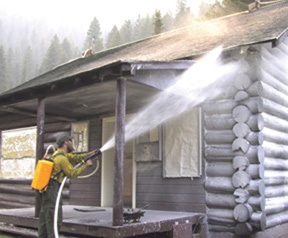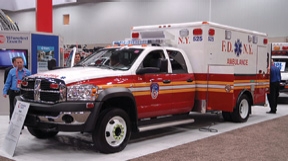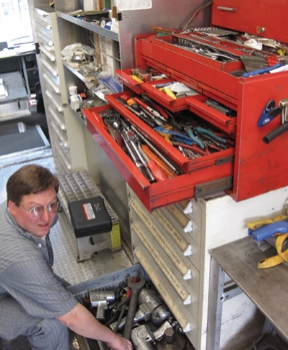 |
| Here, a firefighter uses Barricade’s gel product to protect a home against destruction by wildfire. (Photo courtesy of Barricade International.) |
 |
 |
| TetraKO’s properties allow quick knockdown using less water. (Photos courtesy of EarthClean Corp.) |
 |
| Using an eductor allows departments to batch-mix FireIce gel for storage in an apparatus booster tank. (Photo courtesy of FireIce.) |
The market for firefighting gels, also known as water enhancers, is maturing. There are several players out there, and these products are now being used for structural firefighting. Figuring out where to start isn’t easy. In some cases, using gels mirrors foam operations closely. In others, fire apparatus can travel with gels mixed in their tanks. There are commonalities between both types and vast differences. Either way, if departments choose gel as a tool, firefighters must train on its use. As Chief Richard Marinucci says in his “Chief Concerns” column this month, “There is a saying that if all you have is a hammer, everything looks like a nail! But, everything is not a nail, and many tools are needed to do the job correctly.”
Evolving Technology
When water enhancers first came into the market, their application was mostly in wildland firefighting scenarios. “The first-generation gels were all designed essentially for exposure protection in the wildland urban interface,” says Rob Rosovich, technical director, FireIce.
John Bartlett, founder and president of Barricade International, maker of a liquid-based gel concentrate, explains, “One of its highest and best uses is in the form of a fairly thick, viscous gel that can be sprayed onto structures in front of a wildfire to provide long-term protection—24 to 72 hours or longer, if needed.” He claims the realities of protecting a structure mean that the product has to stick to different substrates. He cites glass windows as one example, long known as one of the weak links in the chain of protection to keep homes from burning down.
Gels today are also being manufactured in powder form so they act as batch mixtures carried in tanks on apparatus. One example is EarthClean Corporation’s TetraKO water enhancer. According to the company’s CEO and founder, Doug Ruth, “We look at our product compared to what we refer to as the first-generation gels that are on the market.” He says his product differs from first-generation water enhancers in five ways:
- There are no superabsorbent polymers in TetraKO.
- While the product looks like a gel, it can pump like a liquid.
- There are no oils in TetraKO.
- TetraKO uses two different gelling agents that cross link when they are heated—one proprietary and the other cornstarch.
- TetraKO, from the beginning, was designed for both structural fire knockdown as well as wildland applications.
Regardless of which generation you use, Rosovich says, “Some of them are liquid concentrates; some of them are also dry granular products. They all work. They do exactly what they’re design function is.” Regarding FireIce, he states, “We’re vastly different. FireIce can be used as a direct suppression agent first and foremost, and then it will double as an exposure protection product, which separates us from all the other gels that are listed with the U.S. Forest Service on the qualified products list, or QPL.”
How Is Gel Used?
Rosovich states FireIce gel can go into ground apparatus such as brush trucks, or it can be batch-mixed into tankers so it can be shuttled back and forth to fill the smaller apparatus and firefighting aircraft. “So, it’s versatile as not only a direct fire suppression agent to attack the fire but also for exposure protection, to actually go into a neighborhood and protect a development just by gelling the homes,” he says. “Then [the fire department] can reallocate its resources as needed. The homes don’t have to be babysat.”
For structural firefighting operations, FireIce disperses heat, and its heat resistance is so great firefighters can open up a straight stream and not have the tremendous steam conversion that firefighters experience in structural firefighting that ends up causing steam burns. “You don’t have that rapid steam conversion. It stays more as a saturated steam vs. becoming a superheated steam, so the conversion ratio is a lot lower,” he says. “With cooling the atmosphere, it also penetrates those different thermal layers that are built up in a room-and-contents fire and actually gets to the fuel package without evaporating. Water immediately evaporates and automatically becomes superheated steam. Foam retards that to a certain degree. It only adds an additional 30 seconds to what water would be before foam starts breaking down. On the other hand, with the water enhancing gels, that time period is much greater. You’re looking at 60 seconds to a minute and a half.”
Ruth adds there are two things to using gel for wildland fires—coating fuels and fire knockdown in general. He says TetraKO technology is very effective for laying down a wet line. “So, if you want to stop a fire from crossing a border, firefighters have found that our technology penetrates the fuel load very well, provides a coating that lasts for hours, and has held back fires on a number of tests.”
In terms of knockdown, the cornstarch used in TetraKO dramatically drops the heat in the wildfires and quickly takes the head out of a fire even with 40- to 50-foot flames.
On the structural side, Ruth says that, on average, TetraKO drops the upper thermal layer in a structural fire by 50 percent in less than 30 seconds. The middle thermal layer is reduced 70 to 74 percent in the same 30-second period of time. “So the heat calorie absorption of our technology in structural firefighting is very important. in terms of faster knockdown, reduced rekindling, and firefighter safety.” Additionally, Ruth claims that in all the fire applications on which the company has used the product, “we’ve found that firefighters consistently use far less water and foam in knocking down the fire. Consequently, because our technology sticks and stays wherever it goes through the upper thermal layer and doesn’t convert to steam, it actually coats and takes that fuel out of the fire, and that dramatically aids in the fire suppression process.”
The Barricade product is liquid-based and is deployed in a similar fashion to foam. It uses an eductor with a jug of concentrate. For wildfire applications, it is used primarily for exposure protection. But, it can be used in structural firefighting as well. “We use different thicknesses depending on what it is we’re trying to do,” says Bartlett. “If we’re trying to stick to glass windows, vinyl siding, and the underneath side of eaves or propane tanks, we use it in a highly thickened form. For extinguishment purposes, we would use it in much lower concentrations. You don’t want a real thick gel falling from an aircraft. You want a thinner gel that wraps the fuel and extinguishes the fire.”
He continues, “Any time there’s a life hazard or structure fire, if we can go in and enhance the water that’s going through the hoses that we carry, we are going to see a quantum leap in firefighting capabilities.”
Placing Gels in Service
Once a department has chosen to employ firefighting gels, there are some purchases to make and some maintenance things to remember.
For powder-based gels such as FireIce and TetraKO, the gel is batch-mixed and stored in an apparatus booster tank until needed. To mix the gel, a department will have to buy the powder and will need an eductor.
“Filling your tank off of a hydrant, you throw the eductor on, throw a bucket on the ground, suck the powder right into the water stream, and you’re off to the races,” says Rosovich. He adds that FireIce has reengineered its eductor system to increase the venturi effect because FireIce is a dry product. Some existing eductor systems will work, but some will not. “That’s why we engineered our own,” he says. “This way, flawlessly, every time you’ll be able to mix FireIce.”
He adds that the company has done third-party corrosion and Forest Service testing, and FireIce has been deemed safe to place directly into the main tank. The powder can sit for 10 years packaged, and mixed it can last up to two years. “We had a fire chief up in New Jersey who filled his extinguisher with FireIce and had it in his command vehicle for two years, never pulled it, and then used it on a fire.”
To mix TetraKO, firefighters primarily use EarthClean’s Powder Blaster System. “This is an eductor that hooks to the discharge on the fire engine, and then we run a line to the top water hatch,” says Ruth. “We get the pump running at 80 psi, and in approximately 90 seconds the powder is sucked into the tank, and we mix for another two to three minutes.” The additional mix is performed by recirculating the tank water.
Once the gel is mixed in the tank, the TetraKO product can stay in the tank from six weeks to three months. At the end of the three months, it can be kept on the truck if it has not begun to biodegrade. If it biodegrades, there will be a slight odor. “At that point, it is still highly effective for fire suppression, but it just smells,” says Ruth. “What we recommend at that point is that you dump it out, fill up your tank, and give it a good rinse.” With TetraKO, as long as the powder is kept dry, the shelf life in the package is indefinite.
Deploying liquid-based gels is like deploying foam. “The way you would do it is you would buy a five-pound bucket of Barricade liquid concentrate. That’s all you would need to buy,” says Bartlett. “Your nozzle selection is important only in that, like with AFFF foam operations and eductors, your nozzle has to be matched to the flow of the eductor.
“The way I would do it is you’d have an eductor set right up onto the discharge ready to go. Some companies prefer to put the eductor onto the discharge of the engine in the time of the need, but the departments that use it regularly for extinguishment enhancement just leave the eductor hooked right up. Run out your standard complement of hose, and match the nozzle to the flow of the eductor. Turn it on, ensure you have suction in the pickup tube, and put the pickup tube into the liquid concentrate and you are flowing gel concentrate. We do not recommend that you flow any higher than a one percent mixture,” Bartlett says. The systems, like foam, need to be flushed out after use. They work with standard eductors already on the market.
All three products work with smooth-bore, variable gallonage, and automatic fog nozzles.
For the Future
Although gels have been around for awhile, at least a decade, Bartlett thinks that they have evolved to the point now where equipment manufacturers will begin to develop products specific for water enhancers. “Now that we have the formulation perfected, we know we’ve got a consistent viscosity of the concentrate, which is an important feature,” he says. “Now we can start the equipment manufacturers making systems that would allow the use of the gel in a much more firefighter-friendly way. There will have to be some variations over the typical foam equipment. As an example, if a little bit of water gets into your foam tank, it’s not a big deal. But if a little bit of water gets into a gel concentrate tank, the hydration process starts, the gel starts to thicken, and that becomes a problem in the system. So, the designers of the system will have to engineer things such as tanks so no water can get in there. The systems have to be flushed out after use, but they have to design the flush-out features to effectively flush out a gel concentrate instead of a foam concentrate. It’s much easier to flush a foam concentrate out than it is a gel.”
Rosovich stresses how gels enhance firefighter safety and health. “This technology is only 10 or 12 years old,” he says. “Is it going to take some time for it to get some momentum? Just a little bit. But, with the combustible materials that are being produced today, the heat release rates of the synthetic materials, and the toxicity of these fuels, departments are looking for newer technologies that are going to increase firefighter safety and not put so much wear and tear on their apparatus or their personnel.” He cites the number of line-of-duty deaths from stress and overexertion. “If I can knock down a fire faster, do salvage and overhaul operations faster, and get that firefighter out of his gear faster, I’m reducing the stress on his body.”
Ruth asserts, “Over time, we expect very broad adoption of [our] technology, and we continue to seek out hands-on distributors that are looking for a game-changing product line. We understand that we have a lot of missionary work to make believers out of the fire service. But, when the fire chiefs look at the firefighter safety, performance, and earth-friendly aspects of our technology, and wanting to get firefighters to their families faster, TetraKO has proven to be very effective.”
Finally, Bartlett asserts, “I think we’re at the point in the development of the gel technology where a lot of firefighters now know that it is a valid technology, that it can be an effective tool. We certainly have success stories. We’ve made it that far in the advancement of the technology. Where we are right now is we have to start educating and taking a look and evaluating the differences in the options firefighters have regarding gels. We can’t just take a salesperson’s word to do this or that. I think we’re at the point in the development of the industry where we need some real-world, reality-based evaluation.”
CHRIS Mc LOONE, associate editor of Fire Apparatus & Emergency Equipment, is a 17-year veteran of the fire service and a captain with Weldon Fire Company (Glenside, PA). He has been a writer and editor for more than 15 years. While with Fire Engineering, he contributed to the May 2006 issue, a Jesse H. Neal Award winner for its coverage of the Hurricane Katrina response and recovery.
More Fire Apparatus Current Issue Articles
More Fire Apparatus Archives Issue Articles

